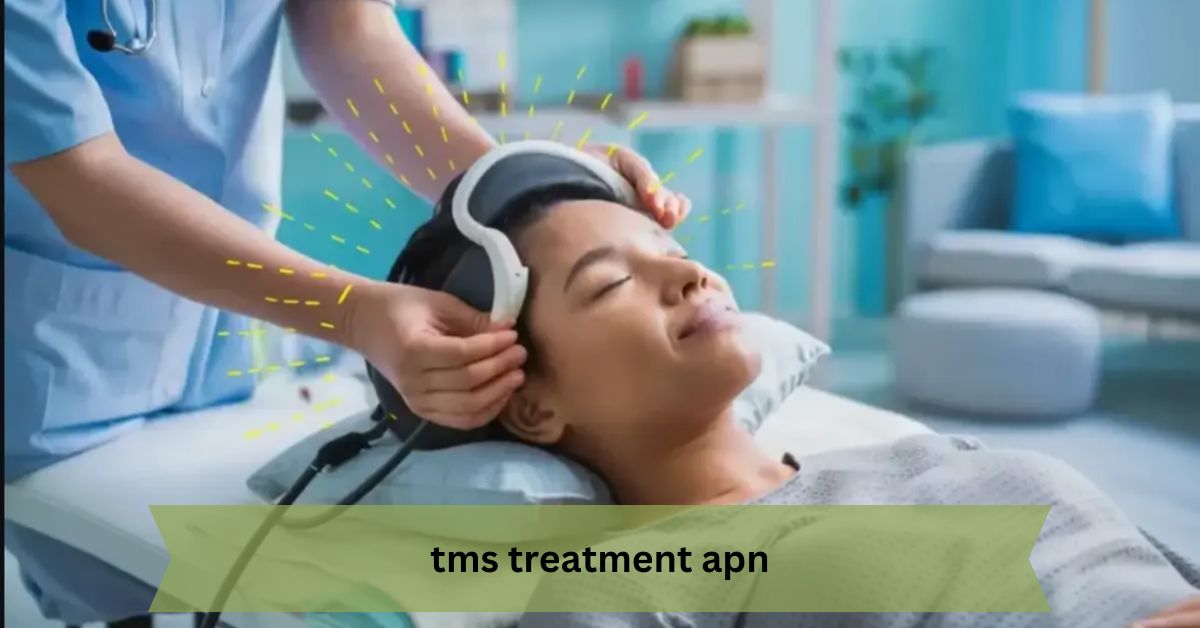Introduction to TMS Treatment
Transcranial Magnetic Stimulation (TMS) treatment is a non-invasive procedure used to stimulate nerve cells in the brain. It is primarily employed to treat depression, especially for patients who have not responded to traditional therapies such as medications or psychotherapy.
This article will explore what TMS treatment is, its applications, and the role of Advanced Practice Nurses (APNs) in administering and managing TMS therapy.
What is TMS Treatment?
Transcranial Magnetic Stimulation (TMS) involves using magnetic fields to stimulate specific parts of the brain. The magnetic pulses target areas of the brain that are underactive in people with depression or other disorders, helping to normalize brain function. It is a non-invasive treatment, meaning that it does not involve surgery or the introduction of instruments inside the body.
How Does TMS Work?
During TMS therapy, a device is placed on the patient’s head, and electromagnetic pulses are sent to specific regions of the brain. These pulses are designed to stimulate neural activity in areas linked to mood regulation, particularly the prefrontal cortex.
The process typically lasts about 20-40 minutes per session, and patients may undergo treatment five times a week for 4-6 weeks.
TMS is FDA-approved for major depressive disorder (MDD) and is considered a breakthrough for people who have not responded to medications or traditional therapies. Recent studies have also suggested that TMS can be used to treat other conditions such as anxiety, obsessive-compulsive disorder (OCD), post-traumatic stress disorder (PTSD), and chronic pain.
Benefits of TMS Treatment
TMS therapy has several advantages over traditional treatments for mental health disorders, making it an attractive option for patients and healthcare providers.
1. Non-Invasive
Unlike other forms of brain stimulation, such as electroconvulsive therapy (ECT), TMS is non-invasive and does not require anesthesia. Patients can resume their daily activities immediately after treatment.
2. Few Side Effects
The most common side effect is mild discomfort at the site of stimulation. Some patients may experience headaches or lightheadedness, but serious side effects are rare.
3. Effective for Treatment-Resistant Depression
Studies have shown that TMS can be highly effective for patients who have not responded to multiple medications and therapies. Many patients report significant improvements in their mood and mental health after completing TMS sessions.
4. No Systemic Effects
Because TMS is localized to the brain, it does not affect other parts of the body, unlike medications that can have widespread side effects.
TMS Treatment and Advanced Practice Nurses (APNs)
Advanced Practice Nurses (APNs) play a critical role in administering TMS treatment, especially in mental health settings. Their involvement ensures that patients receive quality care and that the treatment is tailored to their specific needs.
Role of APNs in TMS Treatment
- Assessment and Screening: APNs assess patients to determine if they are suitable candidates for TMS treatment. This involves reviewing the patient’s medical history, current symptoms, and treatment history.
- Treatment Planning: After determining a patient’s eligibility, APNs help design an individualized TMS treatment plan. This includes determining the number of sessions, the intensity of the magnetic pulses, and other factors tailored to the patient’s condition.
- Administering TMS Sessions: While TMS machines are automated, APNs are responsible for ensuring proper placement of the device, adjusting settings, and monitoring the patient during each session.
- Monitoring Progress: Throughout the treatment, APNs track the patient’s progress, adjusting the treatment plan as necessary. They also work closely with other healthcare providers to ensure holistic care.
- Patient Education: APNs educate patients about TMS, including what to expect during treatment and any potential side effects. This helps reduce patient anxiety and improve treatment adherence.
Why APNs are Important in TMS Therapy
APNs bring a wealth of experience in both medical and psychiatric care. Their advanced training allows them to assess and manage complex cases effectively. In TMS treatment, where individualized care is essential, the skills of an APN ensure that each patient receives a treatment plan that maximizes the chances of success.
Conditions Treated by TMS
While TMS is primarily known for treating depression, ongoing research has expanded its use to other conditions. Below are some of the conditions that can be treated with TMS:
1. Major Depressive Disorder (MDD)
TMS is FDA-approved for the treatment of MDD, especially for patients who are resistant to traditional therapies.
2. Obsessive-Compulsive Disorder (OCD)
TMS has shown promising results in reducing OCD symptoms, helping patients gain better control over their compulsions.
3. Post-Traumatic Stress Disorder (PTSD)
TMS is being used to treat PTSD by targeting brain regions associated with fear and anxiety. It can help alleviate the symptoms that trauma survivors experience.
4. Chronic Pain
Research has shown that TMS can be beneficial for people suffering from chronic pain conditions, such as fibromyalgia, by altering brain activity related to pain perception.
5. Anxiety Disorders
TMS is also being explored as a treatment for anxiety disorders. By stimulating the areas of the brain responsible for anxiety regulation, TMS can help reduce feelings of constant worry and fear.
What to Expect During TMS Treatment
For patients considering TMS therapy, knowing what to expect can help ease any concerns. Below is a brief overview of a typical TMS session.
Before the Session
Before starting TMS therapy, a healthcare provider will conduct a comprehensive evaluation. This includes assessing the patient’s mental health, discussing treatment goals, and explaining the procedure in detail.
During the Session
During the procedure, the patient sits in a comfortable chair, and a specialized coil is placed on the scalp. The machine sends electromagnetic pulses to targeted areas of the brain. Patients may feel tapping or tingling sensations during the process, but it is generally well-tolerated.
After the Session
Patients can return to their daily activities immediately after the session. There is no need for hospitalization or downtime, which makes TMS a convenient option for those with busy schedules.
FAQs TMS Treatment APN
1. Is TMS therapy painful?
Most patients report that TMS therapy is not painful. Some may feel a slight tapping or tingling on their scalp during the procedure.
2. How long does a TMS session last?
A typical session lasts about 20 to 40 minutes, depending on the treatment plan.
3. How many TMS sessions are needed?
Most treatment plans involve 20 to 30 sessions over a period of 4 to 6 weeks.
4. Can I drive after a TMS session?
Yes, TMS treatment does not require anesthesia or sedation, so you can resume normal activities, including driving, after the session.
5. Does insurance cover TMS treatment?
Many insurance providers cover TMS treatment, especially for depression that has not responded to traditional therapies. It is best to check with your insurance company to confirm coverage.
Conclusion
TMS treatment has emerged as a groundbreaking solution for patients who suffer from treatment-resistant depression and other neurological conditions. With its non-invasive nature and minimal side effects, TMS offers hope to individuals seeking an alternative to traditional therapies.



